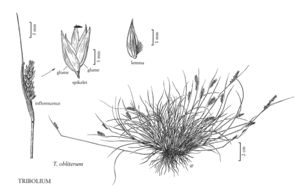Difference between revisions of "Tribolium obliterum"
FNA>Volume Importer |
FNA>Volume Importer |
||
| Line 16: | Line 16: | ||
-->{{Treatment/Body | -->{{Treatment/Body | ||
|distribution=Calif. | |distribution=Calif. | ||
| − | |discussion=<p | + | |discussion=<p>Tribolium obliterum is native to Cape Province, South Africa, where it usually grows in gravelly, well-drained soils at elevations below 600 m. It has been introduced into Australia and St. Helena and was recently discovered in a roadside ditch near Fort Ord, Monterey County, California. It appears to be naturalized there.</p> |
|tables= | |tables= | ||
|references= | |references= | ||
| Line 32: | Line 32: | ||
|basionyms= | |basionyms= | ||
|family=Poaceae | |family=Poaceae | ||
| + | |illustrator=Linda A. Vorobik and Hana Pazdírková | ||
|distribution=Calif. | |distribution=Calif. | ||
|reference=None | |reference=None | ||
| Line 37: | Line 38: | ||
|publication year= | |publication year= | ||
|special status= | |special status= | ||
| − | |source xml=https:// | + | |source xml=https://bibilujan@bitbucket.org/aafc-mbb/fna-data-curation.git/src/314eb390f968962f596ae85f506b4b3db8683b1b/coarse_grained_fna_xml/V25/V25_980.xml |
|subfamily=Poaceae subfam. Danthonioideae | |subfamily=Poaceae subfam. Danthonioideae | ||
|tribe=Poaceae tribe Danthonieae | |tribe=Poaceae tribe Danthonieae | ||
Revision as of 16:19, 30 October 2019
Plants perennial; usually cespitose, sometimes stoloniferous, stolons to 30 cm. Culms 12-40 cm, decumbent or erect, branching intravaginal. Sheaths mostly glabrous, ciliate distally; ligules about 0.2 mm, membranous, ciliolate; blades 1-8 cm long, 0.5-1 mm wide. Inflorescences terminal, panicles, 1-5 cm long, 5-15 mm wide, obovate or cylindrical, with 10-40 spikelets; branches scabridulous. Spikelets 3.5-4.5 mm, with 5-10 florets. Glumes 2.5-3.5 mm, longer than the basal lemmas but exceeded by the distal florets, 5-veined, glabrous or scabridulous over the veins, acute; lemmas 2-3.5 mm, with submarginal tufts of hairs in the lower 1/2, hairs acute, 0.2-0.3 mm, lemma apices acute to acuminate; paleas 1.5-2 mm, glabrous between the keels, sometimes with tufts of hairs on the margins; anthers 0.3-0.5 mm, pale yellow. Caryopses obovate, 0.7-1 mm long, 0.5-0.7 mm wide, plano-convex to concavo-convex, pale brown, smooth; embryos 0.4-0.5 mm; hila 0.1 mm. 2n = 24, 36.
Discussion
Tribolium obliterum is native to Cape Province, South Africa, where it usually grows in gravelly, well-drained soils at elevations below 600 m. It has been introduced into Australia and St. Helena and was recently discovered in a roadside ditch near Fort Ord, Monterey County, California. It appears to be naturalized there.
Selected References
None.
